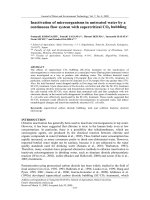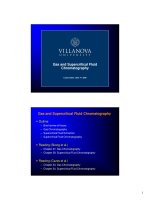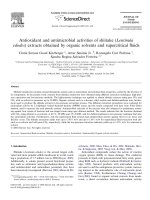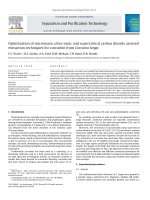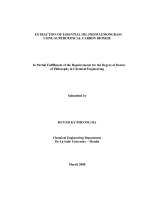Supercritical CO2x
Bạn đang xem bản rút gọn của tài liệu. Xem và tải ngay bản đầy đủ của tài liệu tại đây (3.02 MB, 57 trang )
Supercritical CO2
1
GREEN CHEMISTRY
Trường Đại học Bách khoa TP.HCM
Content
Supercritical
CO2
Definition
Properties of
ScCO2
Application
of ScCO2
Advantages
Limitations of
ScCO2
Content
1. Definition
A supercritical fluid is any
substance at a temperature
and pressure above its
critical point,
where distinct liquid and gas
phases do not exist
1. Definition
1. Definition
1. Definition
CO2
critical temperature
(31.1 °C)
critical pressure
(72.9 atm/7.39 MPa)
2. Properties of ScCO2
very sensitive to small
changes in temperature and
pressure in the vicinity of
the critical point
Properties midway between
a gas and a liquid
The properties of
SCFs vary over a
wide range
depending on the
temperature and
pressure
But intermediate
of gases and
liquids.
Heat transfer characteristics of supercritical
CO2
low toxicity
non flammability
low cost
One of the main differences
between supercritical fluids
and conventional solvents is
compressibility
2. Properties of ScCO2
Selected inorganic supercritical fluids
SCF Symbol Tc (C) pc (MPa) dc (g ml1)
MW m (D)a.
Ammonia NH3 132.4 11.32 0.235 17.03 1.47
Carbon dioxide CO2 31.1 7.38 0.466
44.01 0
Water H2O 374.0 22.06 0.322 18.02 1.85
Benzene C6H6 289.5 4.92 0.300 78.11 0
Ethene C2H4 9.2 5.04 0.214 28.05 0
Ethane C2H6 32. 2 4.87 0.207 30.07 0
Basic Physical Properties
Viscosity
Property Gas SCF Liquid
Density (g cm3) 103 0.3 1
Viscosity (Pa s) 105 104 103
Diffusivity (cm2 s) 0.1 103 5.106
Comparison of the physical properties of gases, liquids, and SCFs
strongly reduced in comparison with
the pure liquid
viscosity
The diffusion
coefficient and
viscosity represent
transport
properties which
affect rates of mass
transfer
Density and
viscosity
increase with
pressure and
decrease with
temperature
Effect of pressure on the density and viscosity of
CO2
viscosity
The diffusion coefficient
varies with both temperature
and pressure and is strongly
influenced by density and
viscosity
Diffusivity
gaseous state > supercritical state > liquid state
the diffusion of a SCF will
faster rate than in a liquid
solvent
Diffusivity
diffusion-controlled
reaction rates
The decrease in
viscosity upon
expansion directly
correlates with
enhanced diffusivity
related to mass transfer
directly proportional to
convective heat dissipation
Self-diffusivity of CO2
The diffusion
coefficient
generally
increases with
temperature at
constant
pressure
Diffusivity
Interfacial Tension
supercritical fluids have no surface
tension
easy and fast diffusing
Interfacial Tension
Interfacial tension of [PF6] in contact with
CO2 at 40 C ( ) and 80 C (∆)
Interfacial Tension
The raw material is exposed to
the fluid and soluble substances
are transferred
especially important in
heterogeneous catalysis
Polarity
CO2 is an UNPOLAR solvent
Polar SCFs may exhibit greater potential for polar molecules
when they contain functional groups that increase the level of
intermolecular interaction with the solvent
Can control polarity
The polarity depend on
teperature and pressure
Polarity
increasing temperature and pressure will
increase the degree of polarization

